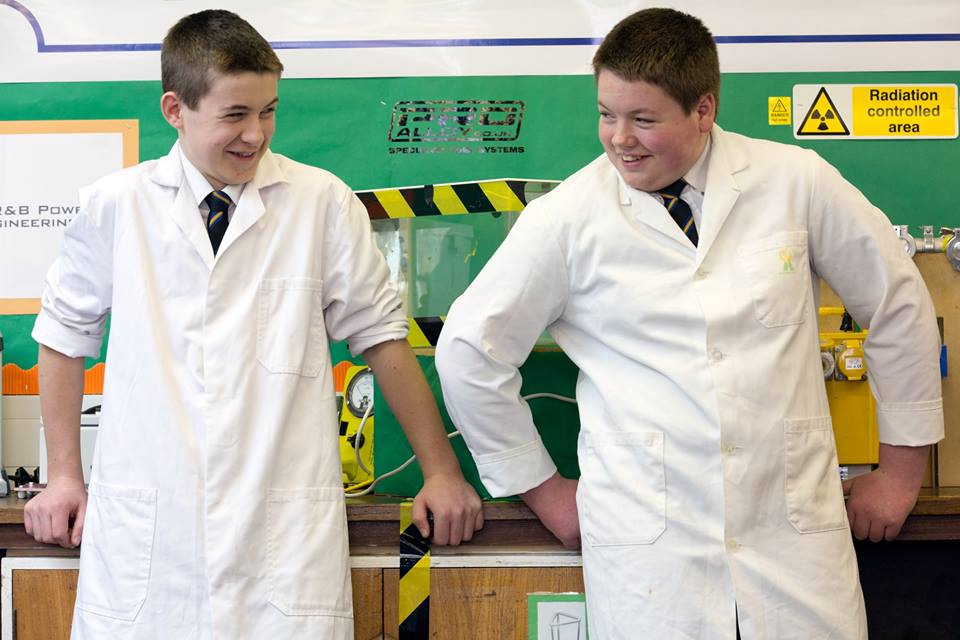Nuclear fusion in the classroom
Interview with
This week a 13-year-old British schoolboy has become the world's youngest person to carry out nuclear fusion. Jamie Edwards, is a pupil at Penwortham Priory Academy in Lancashire. He explained to Chris Smith how  he recreated a star, in a jar...
he recreated a star, in a jar...
Jamie - So, what I've done is I've recreated a process on Earth that happens on the sun on a daily basis. So, nuclear fusion - the process of smashing 2 hydrogen atoms together and making helium. What I do, I have this vacuum chamber and all the air is pumped out of there by two vacuum pumps. Then I add a tiny, tiny bit of deuterium gas - heavy hydrogen - into the chamber. Then I apply about 30,000 volts via an electrode into the centre of this chamber. This rips apart the atom into its electrons and its positively charged nucleus. This positively charged nucleus is accelerated towards the negatively charged electrode. Thousands and thousands of these deuterium nuclei are doing the same thing. Eventually, two of these are going to hit together with a tremendous amount of energy. Fused together then you got a helium atom. But this helium atoms, it's very, very energetic. Instead of releasing the energy as heat, it sends out a high energy neutron. So, you can just get a neutron detector, then you can prove that you've done nuclear fusion.
Chris - The energetic neutron, is that dangerous at all?
Jamie - Well, in large amounts, it could be very dangerous because it's like a very high energy, fast neutron. But to prevent that, I've got like various safety mechanisms in place, tanks of water. They act to slow down the neutron and reduce the energy. Then they're scattered around the room instead of all being directly thrown at me.
Chris - How long did it take you to dream this up?
Jamie - I started in last April and I was looking around for the local nuclear labs like at Sellafield and some of the local universities to see if they'd like, sponsor me into doing a project like this and most of the replies that I was getting were pretty negative really. They were all like, "Thanks, but no thanks." So I thought, maybe if I asked my school and then maybe they could help me. So, I did a Dragons Den style pitch to Mr. Hourigan, my head teacher, he was like, "Yeah, sure. We'll give that a go." I think he's a bit scared at first, but he was alright with it.
Jim - My name is Jim Hourigan. I'm Head Teacher at Penwortham Priory Academy. I had a sort of appointment in the diary from the head of science who said she'd just like to come along with a young boy in year 9 who had a proposal for me. In walked young Jamie and he had a PowerPoint which just said, "I want to build a fusion reactor at Priory. Will you support me?" He talked me through the reasons why he wanted to do it, what was required. He had explained that he'd tried a couple of universities to support him financially. He wasn't getting anywhere, so he'd come to me almost as a last resort because he had this challenge, he wanted to become the youngest fusioneer in the world and he had to achieve that before he came to his 14th birthday and he explained about the young lad in America that had achieved this in 2008, I think it was.
Chris - How much money did he want?
Jim - He costed it and he thought it would cost no more than 2,000 pounds.
Chris - So, did you happen to have 2,000 pounds?
Jim - Yeah, there's always a little bit of money spare. There's always some accounts that don't quite fully spend up. So, it wasn't an extortionate amount of money from my point of view.
Chris - Do you think now that you've returned on that investment, are you glad you made it?
Jim - Enormously so, yeah. Just the impact that we've had in terms of the recognition of the school, of Jamie, what he's achieved. And you can't put money on that. You can't sort of judge that and value that in terms of what we're achieving, but we have a motto at school about being locally respected, nationally recognised. And this is meeting that goal enormously, but that wasn't what we'd set out to do, but it is clearly having that as a spinoff.
Chris - Do you think this is going to translate into more children taking science at a higher level?
Jim - Very much so. We've already had, as soon as children over the last sort of month or so, as they've seen Jamie's project grow and as they've seen the actual reactor develop in one of the labs. We've had children coming to us already asking, can they get involved in other projects. There's a Google science project and there's a few lads and a girl actually want to get involved in that. So already, that sort of enthusiasm is already sort of dissipating into the rest of the school.
Chris - So Jamie, what do you want to do next?
Jamie - In the short term, I want to go on onto doing more research with the fusion reactor that I've got at the minute, looking into uses for these high energy neutrons so they can be made into medical isotopes for uses for detecting cancer, things like that. And then maybe eventually, trying to get nuclear fusion so efficient that it produces more energy out than I've put in. I've already come up with some plans. I'm not going to tell the world just yet.
- Previous Gene therapy makes cells HIV resistant
- Next DNA repair, and cancer










Comments
Add a comment